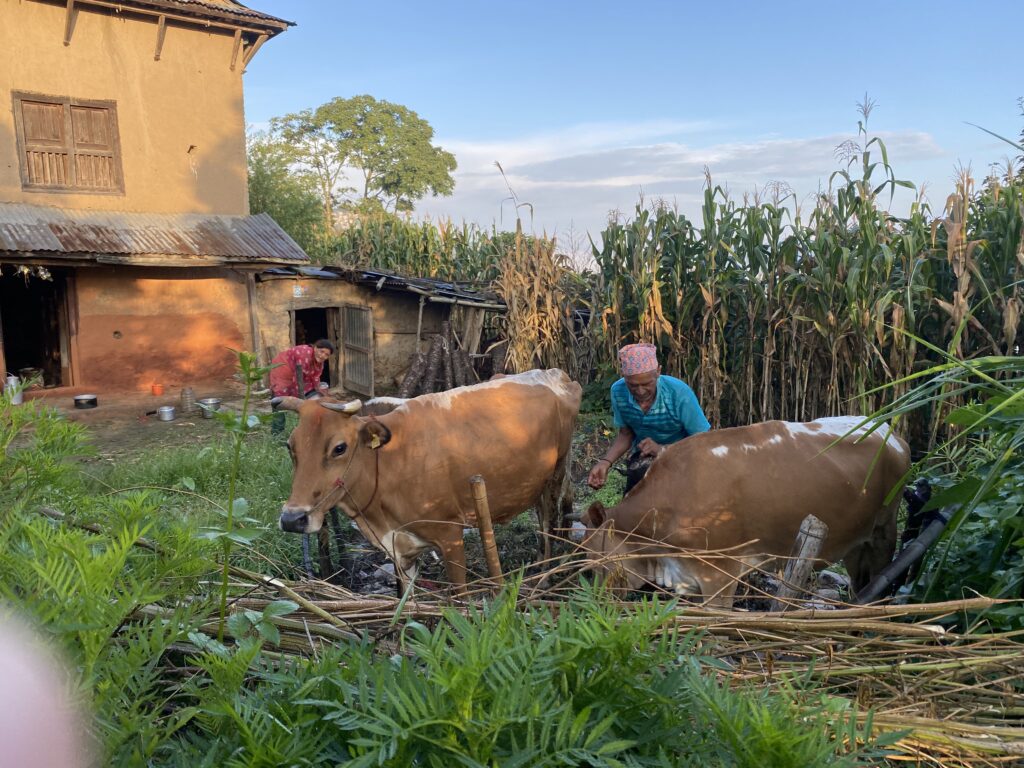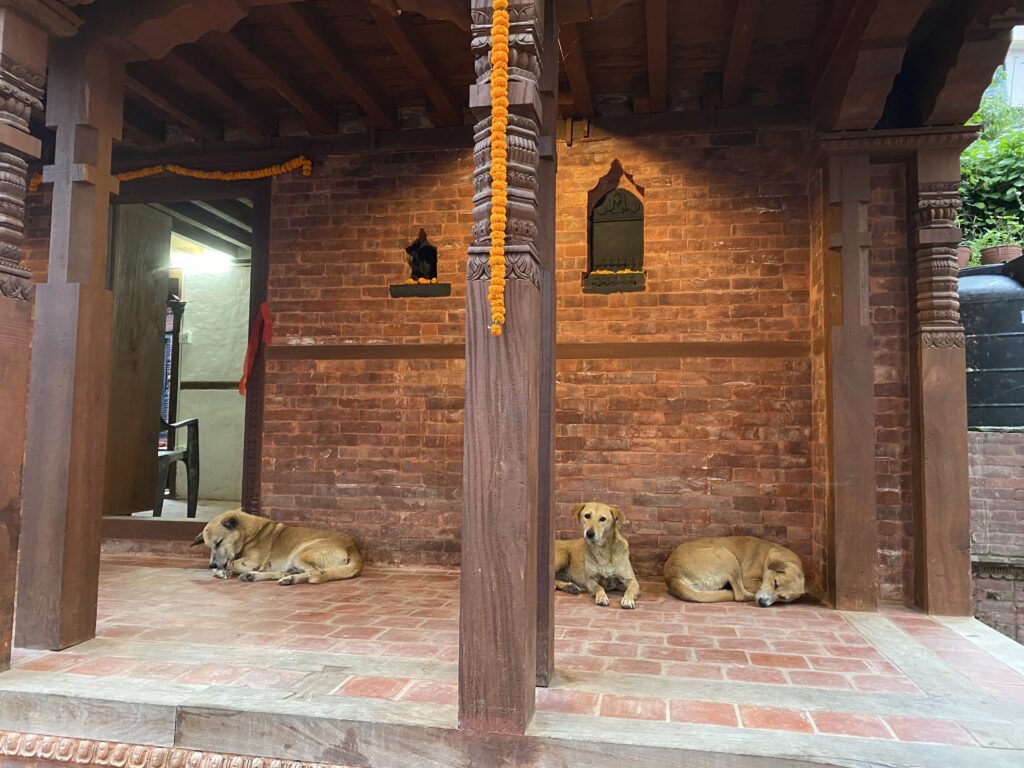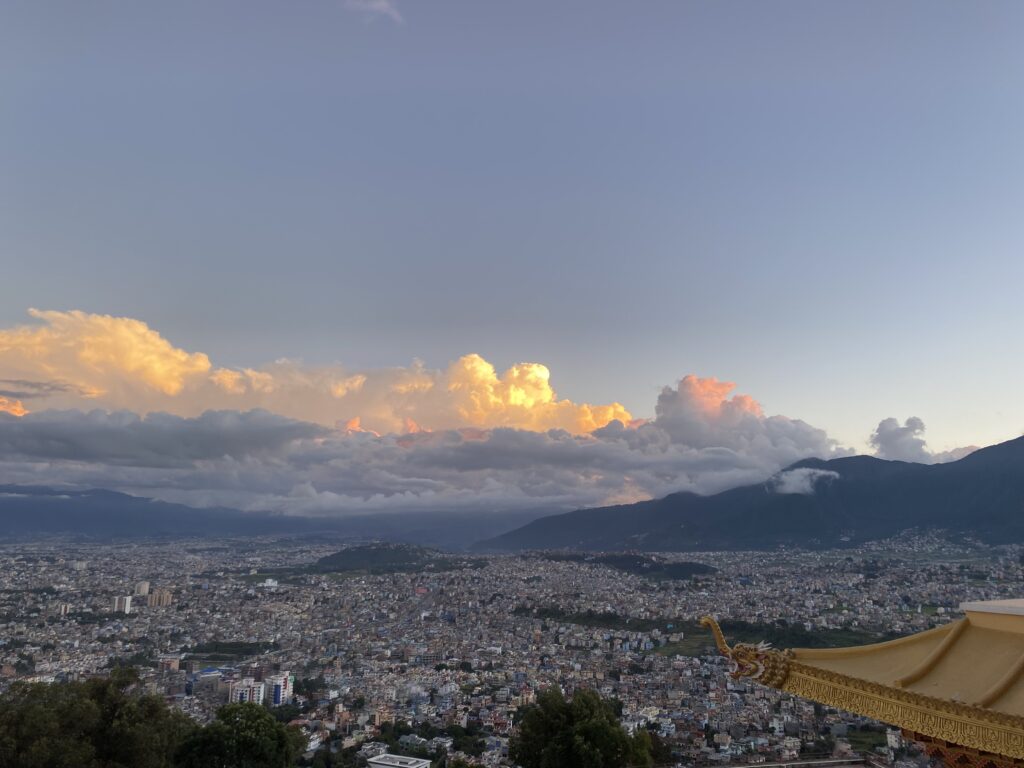If you have ever been to Kathmandu you know it’s a place bulging at every seam….waves and roils of bodies on every street; horns blaring from the overwhelm of traffic; fires smoking and plasticdungtiresbodies burning; sacred sites on every corner; great swaths of walls smeared and pasted with marigold petals, crushed rice, vermillion powder; hundreds, thousands, of dogs barking all at once…. it’s a sea of humanity, animals, death, glory and history spread out over the ancient valley it is built within, ringed by the highest mountains on earth and held in the arms of the gods.





I arrived two weeks early for the retreat I came here for, and spent that time congratulating myself on my gamechanging jet lag app, learning how to navigate the rot and roil referenced above, and getting to know the three other early students and the three western teachers with whom I shared the entirety of our monastery guesthouse. I walk and walk, wade through the heat and the humidity, hike up to temples, re-acquaint myself with the eye-watering squat toilets I remembered from my life in Shanghai so long ago. I peer over bridge sides at the sacred Bagmati River, which runs to the Ganges. Choked with garbage, it breaks my heart.






Some nights I go to the puja at the ornate gompa shrine room where the 200 monks who live here go to chant and worship multiple times each day. I sit in the back, incense wafting, those iconic and discordant Tibetan horns blasting me up and out of ordinary thought. I sit next to my devout fellow student Yen-Hui, chant notes in her hands painstakingly translated by her from Tibetan to Mandarin to English so that she can follow along.
I myself am not chanting. It is all I can do to bear the insanity of the horns, the technicolor glare of the yellow, red and blue fabric hangings covering every surface and drowning out my strong preference for calming neutrals, the contorted faces of Mahakala and Palden Llamo snarling down from the walls, the giant portraits of HH the Dalai Lama and our teacher Yongey Mingyur Rinpoche smiling down on us, framed and swathed in disconcertingly Trumpish lashings of gold.
Now, it is four weeks past those first few days, and the Sturm und Drang of the beginning has slowly given way to a new routine… tenuous and unfamiliar, quite uncomfortable, but strange enough to jolt me out of my regular mindstream and into, at least here and there, the gap that arises between known places and feelings, the one our teacher encourages us to keep an eye out for, the one that invites, when I’m lucky, a tiny glimpse of the luminous and empty nature of mind I am here to practice.








I get up before it is light six mornings every week, a good four hours before it is my custom and comfort. The coffee with sugar and cream that Hans makes for me at home has been replaced with milk tea, and the familiar routine of personal preference is long gone as I walk in the dawn up the hill to the gompa, through the construction site that is the new monastery being built in the wake of the 2015 earthquake. There are sheer drops at every turn, gaping and open elevator shafts, mud and dogs, and many perilous stairways down which I hug the wall to avoid the grievous impalement waiting if I tend more to the view than my footing.
The scale is immense, on par with the Sistine Chapel or Notre Dame (not a joke!), and there are no barriers, no rules, I just walk on through, past the masons and the monks and the children and the dogs, past the artisans who are hand carving every inch of the facade into endless and intricate animals, birds, symbols and deities, past the sweep of the city beneath our steep hill, the smoke and smog and clamor wafting up.
We are high above the city here, so high, and yet the sounds and colors and swarm of it all comes up anyway, swirls into eyes and ears and lungs, even in the darkness of dawn, making its way past the countless swaths of tattered prayer flags and the great black kites who wheel through these skies. Awe and confused grandeur slowly come into focus each morning, the visual version of those Tibetan horns permeating my every sense at the same time as the first soaking sweat of the day permeates my clothes, a coil of wet fabric wound around my body until nightfall.
It is all so foreign, so loud, so unfamiliar, that there is nothing to be done but surrender to it all, mute, subdued, too sweaty, confused and in awe to do anything else.
Our teacher, Yongey Mingyur Rinpoche arrives the second week and we were graced with four precious hours each day with him. This is quite something – he teaches around the world in halls holding many hundreds of people at a time. To be in a group of just thirty students is a great privilege, a literal treasure, and a remarkable opportunity. We listen closely, we join in with his abundant laughter. His light heart lifts each one of our own. His luminosity is undeniable.


To receive teachings from such a person, a highly realized master, is a humbling thing. My complaining self, the one who takes my own comfort as a matter of high importance, keeps quiet. Who I am to want to fine-tune my environment in the presence of this teacher and these people, to hush the chattering monks outside my window at all hours, kill with a look the strange American in our midst who has a laugh straight out of an insane asylum, so piercing and so loud my heart lurches each time I hear it?
Who am I to wonder where exactly the milk in my milk tea is from or is it possible to unclog the drain in my bathroom as I spend my days navigating children on the street who wrap their crusted arms around my legs, mothers with sick babies on their backs and hands plucking at my shirt, dogs wretched and untended on every corner. I listen to that unhinged laugh each morning, shift on my cushion to minimize how much of my skin touches the wet shroud of sweaty linen that I wear each day, wake up to the monks making eye contact straight through my window, and surrender to all of it, embarrassed that I even think of desired improvements to my sheets, window treatments, auditory experience or dinner options.
If it all sounds a bit like a slowly unfurling hallucinogenic trip, then I am doing a good job describing it to you. It’s been a while, but often it feels exactly like that.



And then, there’s the beauty. At the sacred stupas where we go to walk kora, crimson swoops of vermillion on the foreheads of so many, including me if I don’t step quickly around the holy man attempting to christen (buddha-en?) me with his dripping brush. We circumambulate the great domes with Buddha’s half closed and unmistakable gaze looking out at every direction, we spin the massive and worn prayer wheels until our hands are tired, and no longer clean. Heads down, mantras whispered, prayer flags and smoke filling the air around our heads. I think about home, my children, the wonder of being here, and yes, liberation.


These are some of the most ancient and sacred sites in all of the Tibetan disaspora, and it is said that a prayer to Swambuyu, one of the three stupas I have visited thus far (along with Boudha and Namo Buddha), is thirteen-billion times more effective than one said anywhere else. Billion with a b, because that is the scale here – numerically, historically, physically, acoustically – it is mind-bending and mind-blowing. Mind-recognizing too I am told, if I can do it right 🙂
I bow my head, and keep it up with the om mani padme hum, hoping that all those billions and billions of virtues are accruing, along with possibly paneer masala for lunch. Karmic obscurations, destructive emotions, surely, oh surely, falling off of me and into the mud and dog shit under my shoes.
On the day we go to Pashupatinath, the cremation ghats along the fetid and sacred Bagmati River, we walk by the fires, the bodies, the dogs, the caves, the persistent and filthy river, and the audible grief of so many who are helping to say goodbye to their loved person. Nothing is hidden, not the bodies, or the heartbreak. I look into their crumpled faces, and I hear their cries and sobs, and I feel the stirring in my own broken-open heart. Wanting to be happy. Wanting to escape suffering. Just like me. Just like me.



In between the meditation, the classwork, the meals, the eachings, is the community, the heaven and hell of other people. The worst parts of myself rise to the surface and writhe and slither over me… the critical thoughts, the judgements, the irritations. Any illusions I might carry about my bodhisattva tendencies are kept in check by the constant close contact with these several other dozen beings doing their best, but driving each other crazy (at times) anyway.
It is good practice for the key point of our presence here: to wake up to the nature of our minds, and in doing so, remember that everything we do, however misguided or confused, is try and come home to a place of comfort and of ease. And that our most sacred work is to help other people.
Through action at some point, yes, sure, maybe, but we are also told over and over again that this benefit is as real and impactful through aspiration, through intention and motivation, through purifying our own misunderstandings about who we are really are and what we are really capable of. That as we shed bits of our misapprehension, as we breathe in the suffering of others and breathe out comfort and ease and love, our very being is of benefit to the world. That just by “taking seven steps towards our cushions” each day, we are easing suffering in the world.



I’m in, I buy it. So much suffering in each of our hearts, and all around us. How can we heed that call?
It’s a life changing thing to spend all day, every day, on such things. Every day, many hours of lecture, three hours of meditation, three hours of seminar, meals in an echoing room with 40 other people. I fall into my narrow bed , mind spinning. The dogs bark all night long.
I don’t know the ways it is changing me, but surely, it must be.
It doesn’t all make sense, and, I know it doesn’t have to. My life has brought me here, to the top of this hill, to the top of this soaring monastery, towering about this ancient city, but dwarfed by the roof of the world. Self and concept and form collapse all around me, my own seismic shifts shaking it all into the rubble around my feet.
The bad news that I am hurtling through space without a parachute is my constant companion, to my despair, but the inseparable good news is here too: there’s no ground. The illusion of disaster looming on the horizon is unmasked as a dream, despite a lifetime of getting really good at watching for it. Without that, without the phantom of safety, permanence and me-ness, everything changes. Everything becomes more simple. At least, for now.
Send prayers, send love, send me good fortune and some fortitude. I send them all from my heart, right back to yours.
“The best protection is nothing to protect.”
Yongey Mingyur Rinpoche



wow Kathleen. thank you for the 10 minute submersion ( 20 since I re read it) into the world you’ve stepped into with such clarity, observation and without judgement. you so colorfully relate your longing to absorb ALL of it I can’t help but feel the sweat, the joy, the grit, the awe and the communal swirl of living with eyes and heart open in service and without expectations..
I’ve no doubt you’ll bring much of that home and spread it throughout our community as an opportunity to shift our lenses.🙏🏽
Wow is right!
I am sure that what you are explaining will stay with you the rest of your life. Your words are beautiful, comfortable, uncomfortable, grimy, earthy, and even heavenly.
I am proud of you.
Love,
Dad
What an amazing journey you’re on!
My dear Kathleen,
I haven’t been to Kathmandu in almost 30 years, and yet through the power of your words , I can vividly recall both the grit and glory of my time in Nepal. I honor and bless your journey into the realms of “no ground”; Thank you for bringing me along on your adventure. xoxo Elizabeth.
Thank you for so eloquently and beautifully sharing a glimpse into your life.
I am sending love and best wishes for you in your courageous quest. Kim